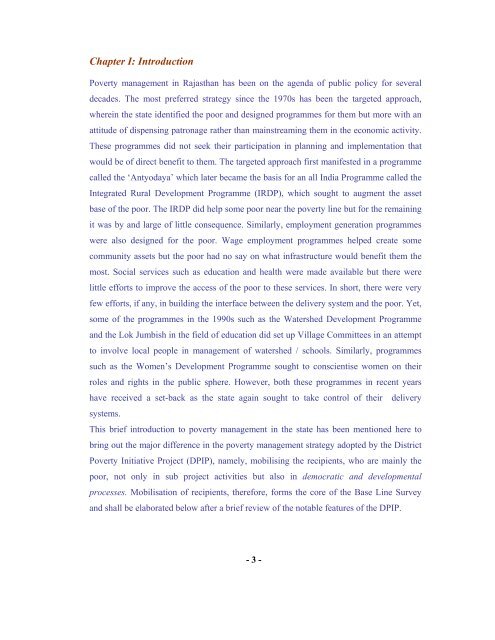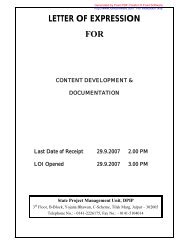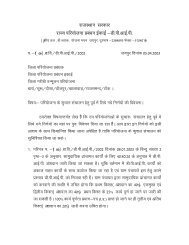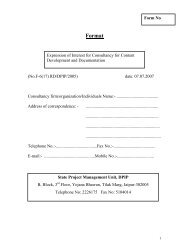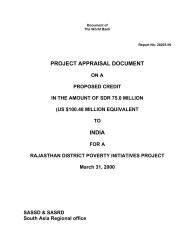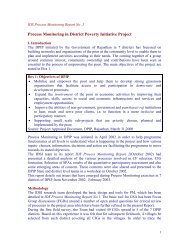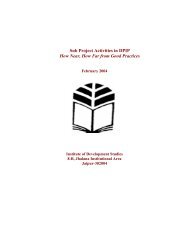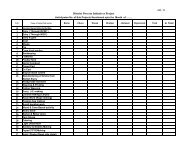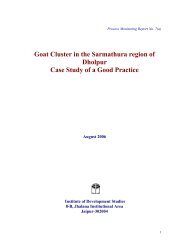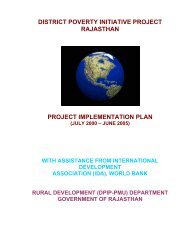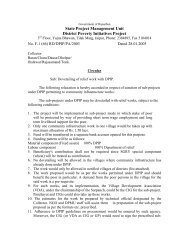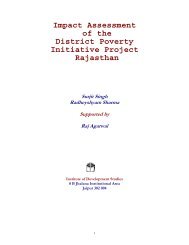PrefaceThe Government of <strong>Rajasthan</strong> has collaborated with the World Bank in designing andimplementing the District Poverty Initiative <strong>Project</strong> (DPIP) in seven districts in the state.These are Baran, Churu, Dausa, Dholpur, Jhalawar, Rajsamand and Tonk. A Base LineSurvey of 800 households in each of the 7 districts was carried out to establishbenchmarks for outcome indicators of the DPIP. The survey was carried out during theperiod February - June 2001. The Base Line Survey covers both economic and socialaspects of livelihoods of the poor and the non-poor.The Base Line Survey Indicators include those that cover area poverty given the naturalresource endowment and the physical infrastructure. Area poverty includes aspects such asLand Use Pattern, Status of Water Bodies, Status of Agriculture including Livestock.Poverty of infrastructure is reflected in the status of economic infrastructure such astransport, electricity and markets, and social infrastructure such as education and health,agriculture extension, veterinary services and banking. The Base Line Survey also collectsinformation on local institutions such as the Panchayati Raj, Caste Panchayats,untouchability, jajmani system and religious institutions, Government interventions,violence against women and the Government and Civil social capital.Indicators based on the poor and non-poor sample households include those with respectto the resource base, the demographic pattern, occupational characteristics, disparities inasset ownership, productivity of land and livestock, skills, capacities to access servicesand organize, gender based differences in access to services, nature and functioning ofinformal networks and associational social capital.The authors would like to thank the team of Advisors including Prof. D B Gupta, Prof.Nirmala Murthy, Prof. N K Singhi, Prof. M S Rathore, Prof. Sunil Ray, Prof. KanchanMathur and Dr Shobhita Rajagopal with whom we interacted at various stages of thework. They have all made valuable contributions that are gratefully acknowledged.The Base Line Survey Team comprised of a team of 30 members, namely, Dr. N.R.Sharma, Tanwar Singh Rathore, Gopal Singh, Bhagirath Singh, Aidan Singh, Atma RamKoli, Suresh Kumar Rawat, Anoop Kumar Sharma, Devendra Singh, Ramesh Asliwal,Ram Singh, Ram Kumar Chhaba, Surendra Jain, Om Prakash Chhaba, Karni SinghRathore, Om Prakash Khatik, Mahendra Chaudhary, Ramesh Bairwa, Rajesh Mohta,Laxmi Narayan Bunkar, Ramesh Sharma, Bhagwati Singh, Jwala Pratak Singh, NaveenKumar Gupta, Manju Balana, Neeta Sharma, Dr. Neeta Kumari, Rekha Sharma, RashmiVerma, Sadhana Sikarwar, Members of the Base Line Survey team put in hard work anddid the field work especially in the months of May and June. Mr. Rajesh Pareek ablysupervised data entry and assisted in furtehr analysis of data. We thank them all. We alsothank the respondents who made themselves available to fill in the questionnaire.Pradeep BhargavaRadhey Shyam Sharma- 2 -
Chapter I: IntroductionPoverty management in <strong>Rajasthan</strong> has been on the agenda of public policy for severaldecades. The most preferred strategy since the 1970s has been the targeted approach,wherein the state identified the poor and designed programmes for them but more with anattitude of dispensing patronage rather than mainstreaming them in the economic activity.These programmes did not seek their participation in planning and implementation thatwould be of direct benefit to them. The targeted approach first manifested in a programmecalled the ‘Antyodaya’ which later became the basis for an all India Programme called theIntegrated <strong>Rural</strong> Development Programme (IRDP), which sought to augment the assetbase of the poor. The IRDP did help some poor near the poverty line but for the remainingit was by and large of little consequence. Similarly, employment generation programmeswere also designed for the poor. Wage employment programmes helped create somecommunity assets but the poor had no say on what infrastructure would benefit them themost. Social services such as education and health were made available but there werelittle efforts to improve the access of the poor to these services. In short, there were veryfew efforts, if any, in building the interface between the delivery system and the poor. Yet,some of the programmes in the 1990s such as the Watershed Development Programmeand the Lok Jumbish in the field of education did set up Village Committees in an attemptto involve local people in management of watershed / schools. Similarly, programmessuch as the Women’s Development Programme sought to conscientise women on theirroles and rights in the public sphere. However, both these programmes in recent yearshave received a set-back as the state again sought to take control of their deliverysystems.This brief introduction to poverty management in the state has been mentioned here tobring out the major difference in the poverty management strategy adopted by the DistrictPoverty Initiative <strong>Project</strong> (DPIP), namely, mobilising the recipients, who are mainly thepoor, not only in sub project activities but also in democratic and developmentalprocesses. Mobilisation of recipients, therefore, forms the core of the Base Line Surveyand shall be elaborated below after a brief review of the notable features of the DPIP.- 3 -


